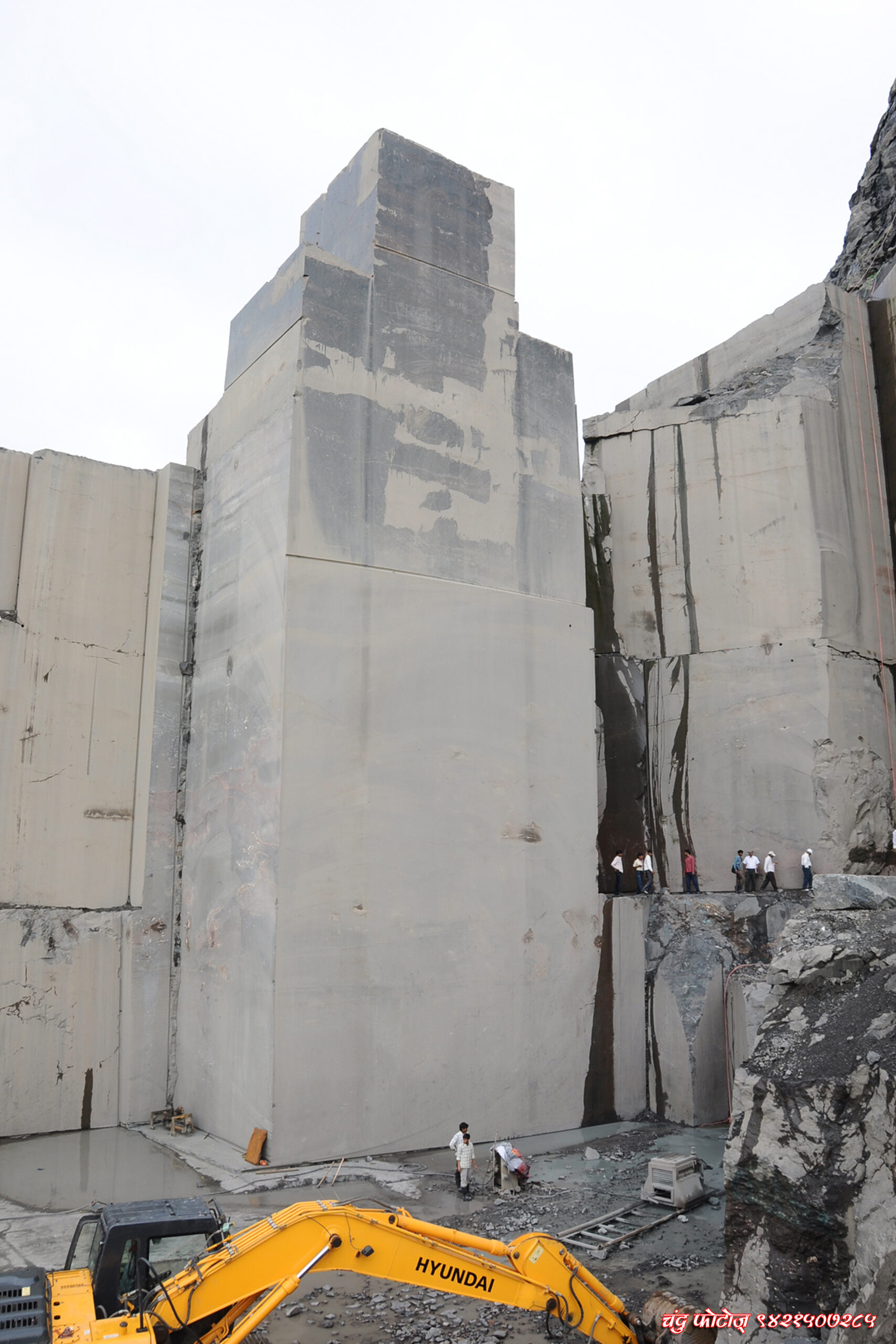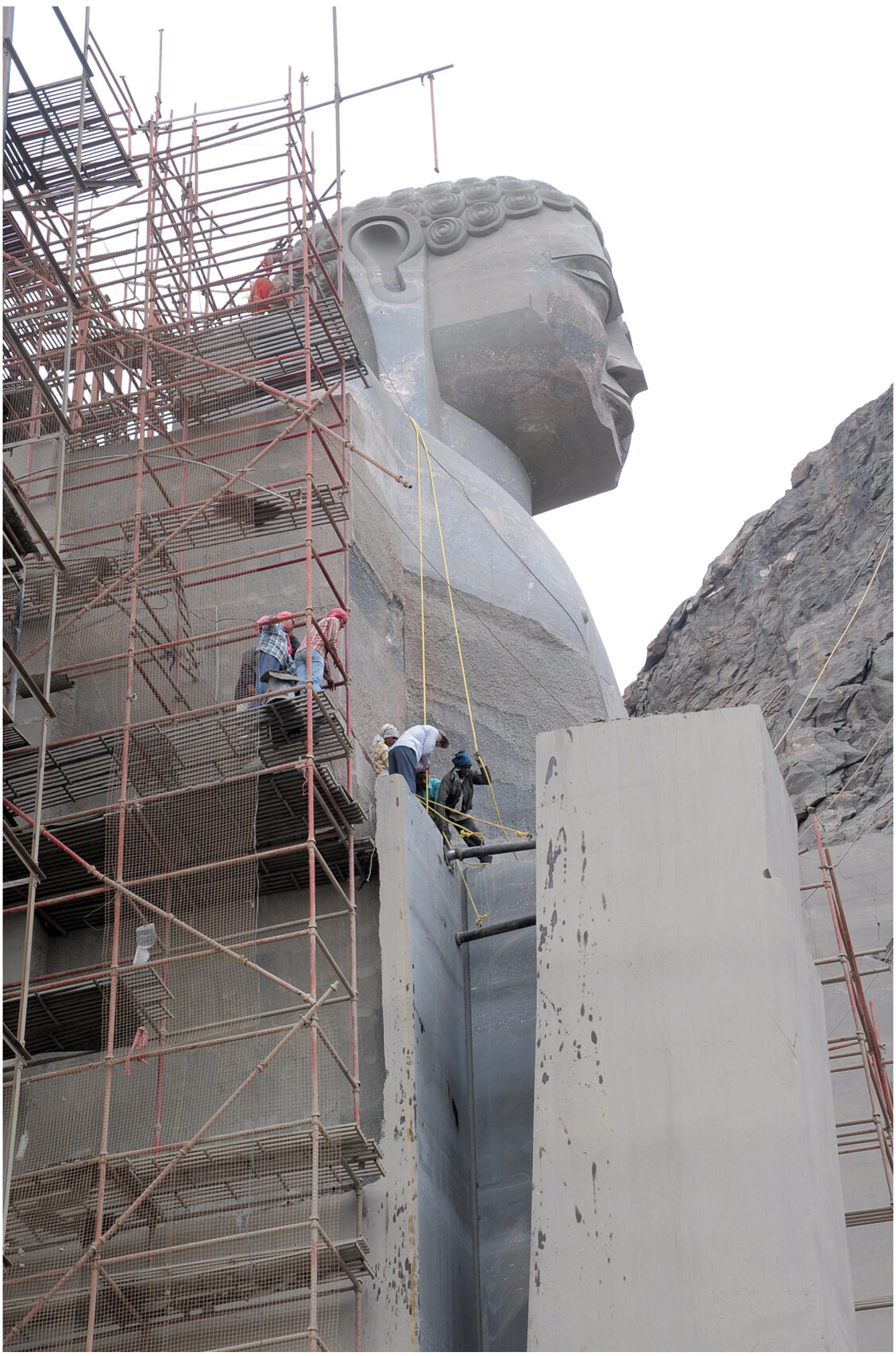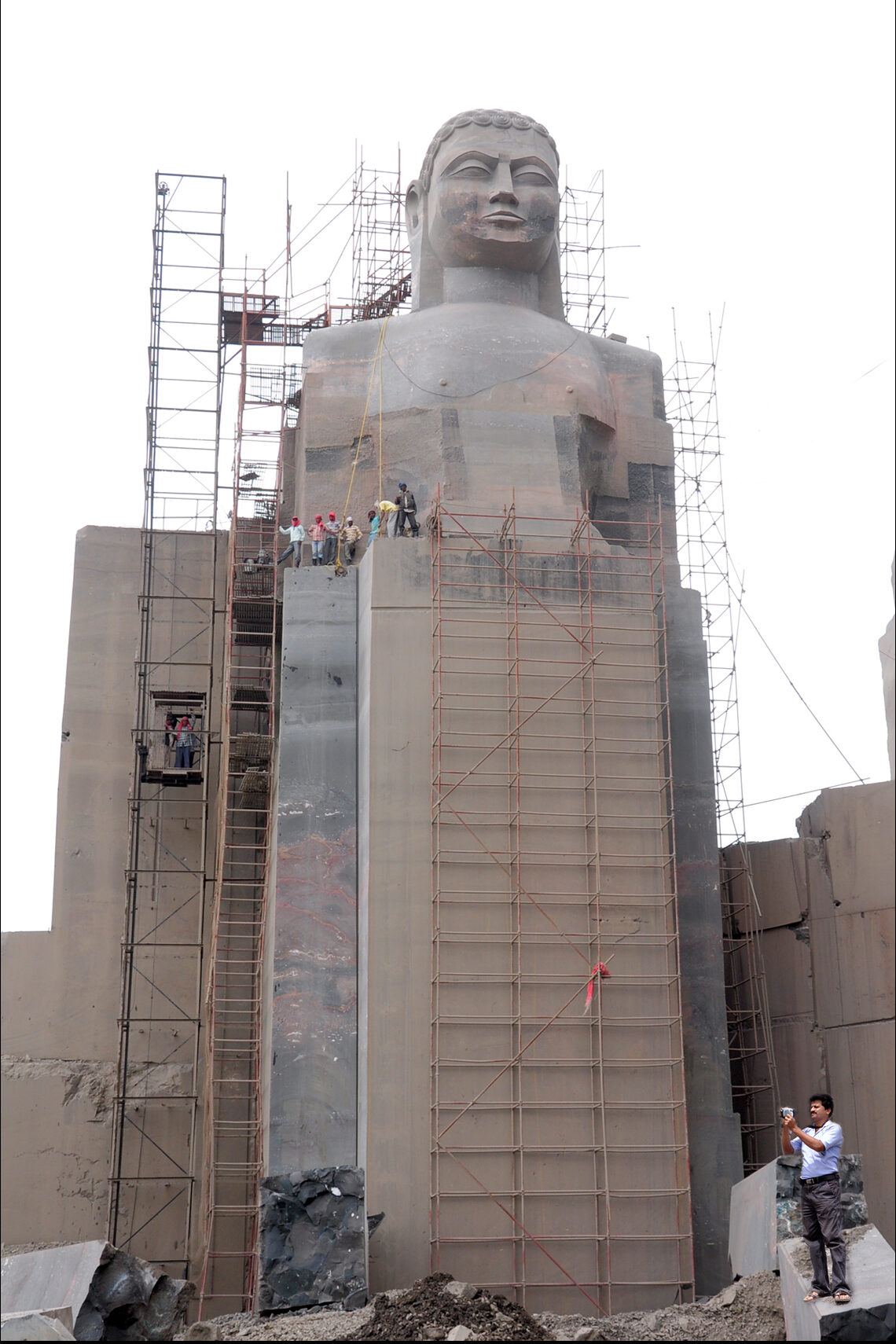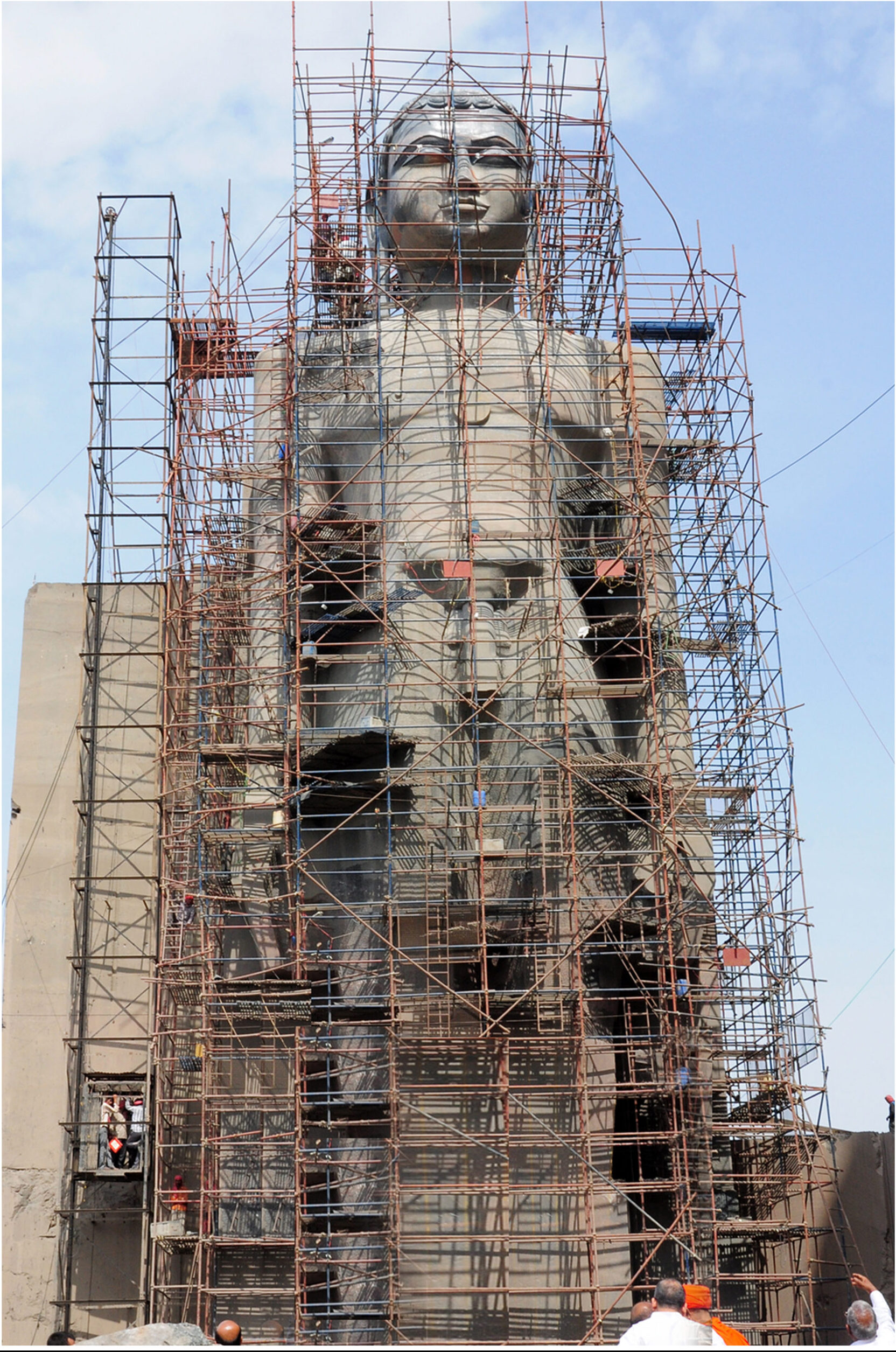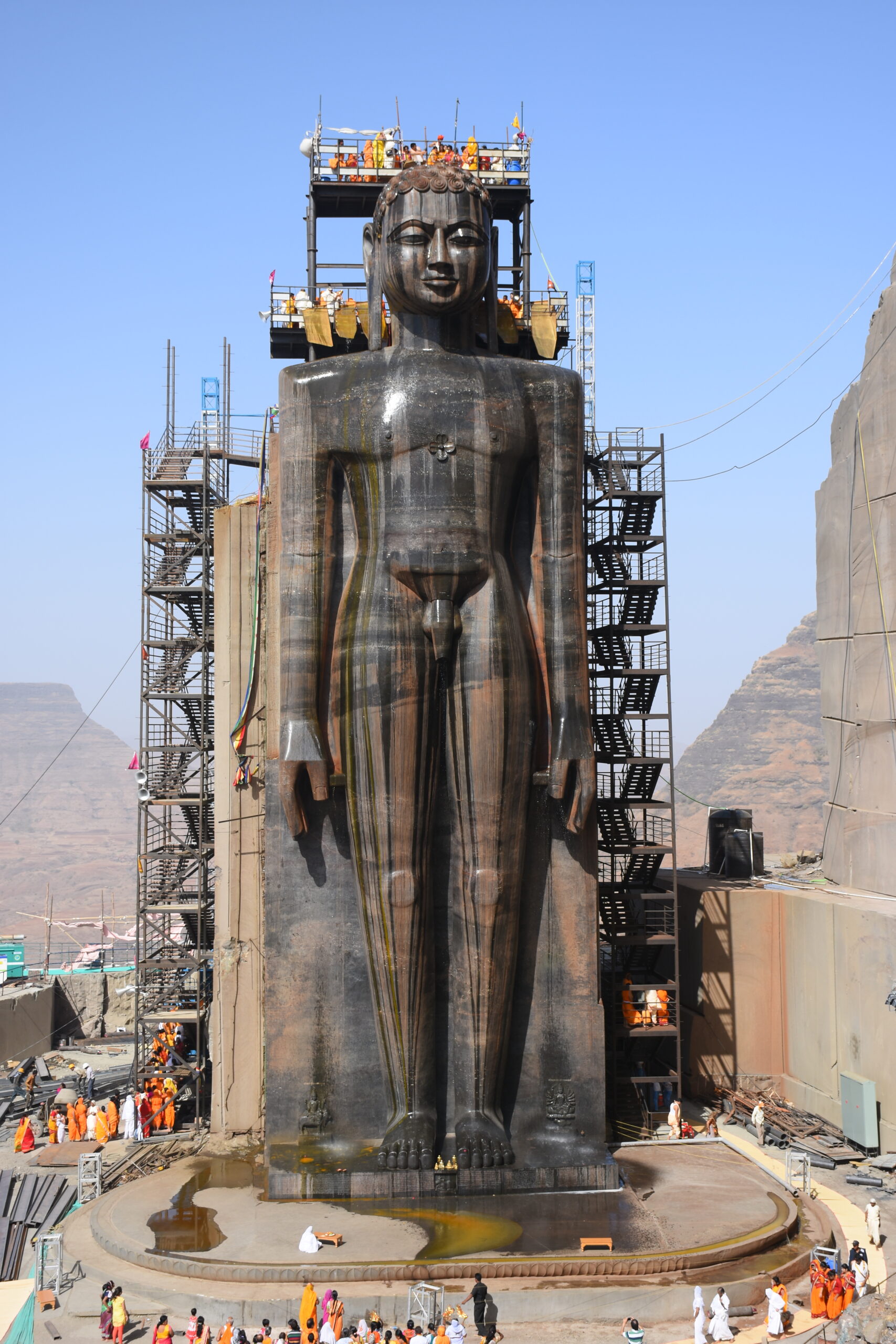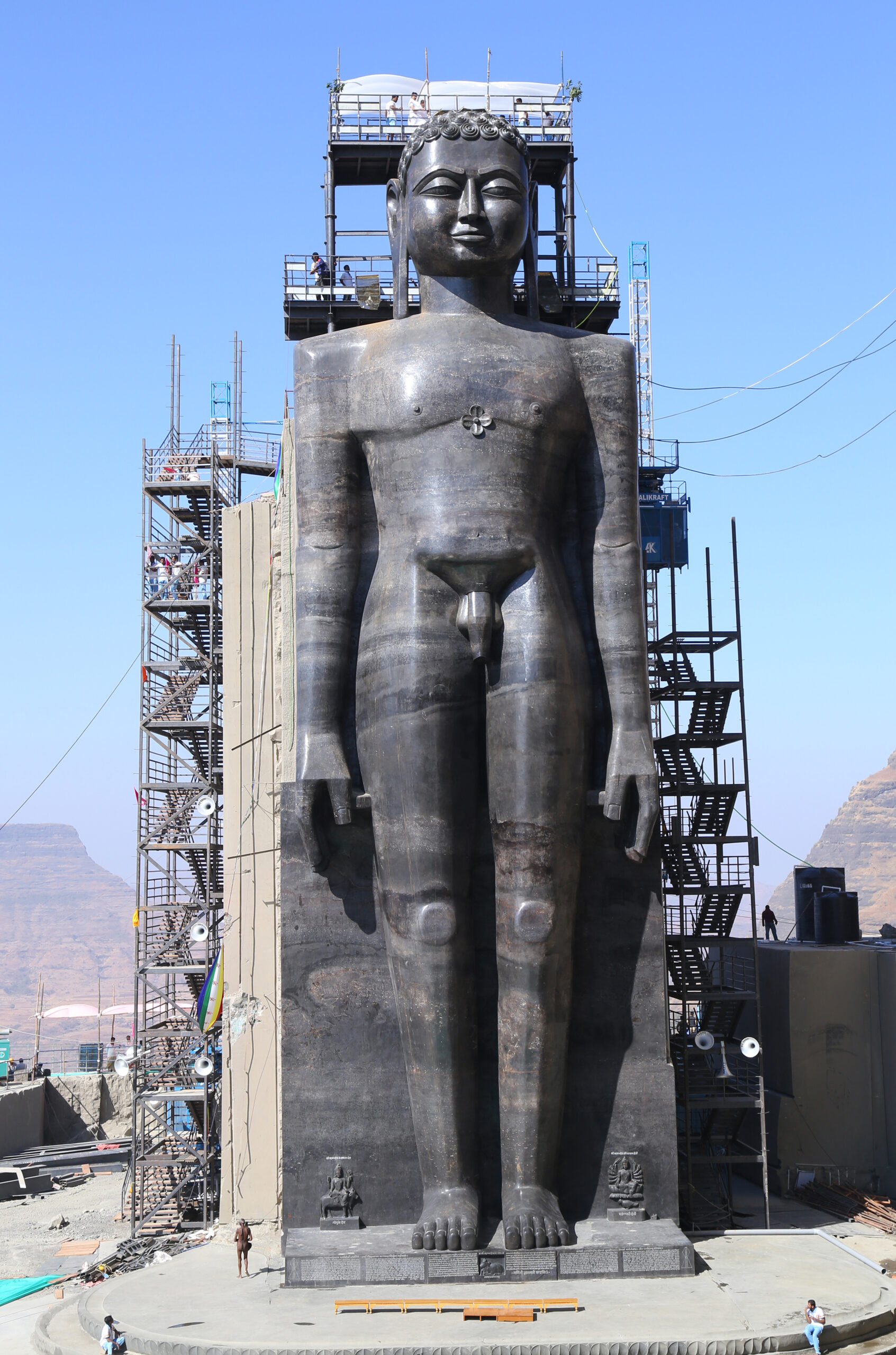Exclusive Idols
Statue of Ahimsa
The Statue of Ahimsa is a 108-foot-tall Jain statue in Mangi-Tungi, Nashik, Maharashtra, India. It’s the tallest Jain statue in the world and depicts the first Jain Tirthankara, Rishabhanatha. The statue is carved from a single rock in the Mangi-Tungi hills, which are sacred to the Jain community.

HEIGHT
108 Feet

LOCATION
Mangitungi

ESTABLISHED
2016

MATERIAL
Stone
Parasnath Bhagwan
This exquisite idol of Parasnath Bhagwan, sculpted in Bhainslana black marble, stands out for its majestic 1008-fan serpent hood (fani). Each hood features delicately carved holes that allow abhishek water to flow seamlessly during rituals, creating a divine cascade from the hood to the idol’s body.
This spiritual marvel is not only an architectural feat but also a visual spectacle during the daily abhishek, where the water gently streams down the fani like natural rainfall—symbolizing purification, devotion, and grace. Its sheer scale and dynamic design make it a one-of-a-kind creation in Jain art.
- Feature: 1008-Fan fani with waterflow during abhishek.
- Significance: Symbol of purity and intricate Jain artistry.

HEIGHT
61 Inch

LOCATION
Rana Pratap Bagh, Delhi

ESTABLISHED
2019

MATERIAL
Bhainslana Black Marble
Bharat Bhagwan
Installed at the sacred Digamber Jain Mandir, Ayodhya, this 28-foot statue of Bharat Bhagwan is carved from premium granite, symbolizing strength and dignity. It represents Bharat Chakravarti, son of Rishabhnath, an important figure in Jain and Hindu mythology.
Ayodhya, a city deeply rooted in Jain history, is also known as the birthplace of several Tirthankaras. This idol honors the legacy of Bharat Chakravarti, reinforcing Ayodhya’s spiritual importance.
- Significance: Symbol of Bharat Chakravarti’s legacy.

HEIGHT
28 Feet

LOCATION
Digambar Jain Mandir, Ayodhya

ESTABLISHED
2025

MATERIAL
Granite
Bharat Swami
Located in the heart of New Delhi at Gyanasthali Tirth, this magnificent 31-foot idol of Bharat Swami is crafted from grey sandstone.
This temple is a symbol of inner knowledge, discipline, and Jain unity in the capital city. Its calm spiritual energy, combined with modern infrastructure, provides a peaceful setting for reflection and worship.
- Accessibility: Wheelchair-friendly

HEIGHT
31 Feet

LOCATION
Gyanasthali, Connaught Place, New Delhi

ESTABLISHED
2021

MATERIAL
Grey Sandstone
Bahubali Bhagwan
This 35-foot idol of Bahubali Bhagwan, carved in grey sandstone, is situated at Sadhuvrati Ashram, Badegaon, Uttar Pradesh. The sculpture reflects serenity and supreme renunciation, embodying the soul’s detachment from the material world.
Theme: Renunciation and inner peace.

HEIGHT
35 Feet

LOCATION
Badegaon, Uttar Pradesh

ESTABLISHED
2018

MATERIAL
Grey Sandstone
Adinath Bhagwan
Carved from Makrana white stone, this 29-foot idol of Adinath Bhagwan (Rishabhnath) stands gracefully at Digamber Jain Mandir, Ayodhya. The calm expression and delicate detailing symbolize spiritual awakening and the beginning of the Tirthankara tradition.
Ayodhya, being his birthplace, makes this idol especially sacred and revered by Jain devotees.
- Significance: Birthplace of Adinath Bhagwan.

HEIGHT
29 Feet

LOCATION
Digamber Jain Mandir, Ayodhya

ESTABLISHED
20xx

MATERIAL
Makrana White Stone
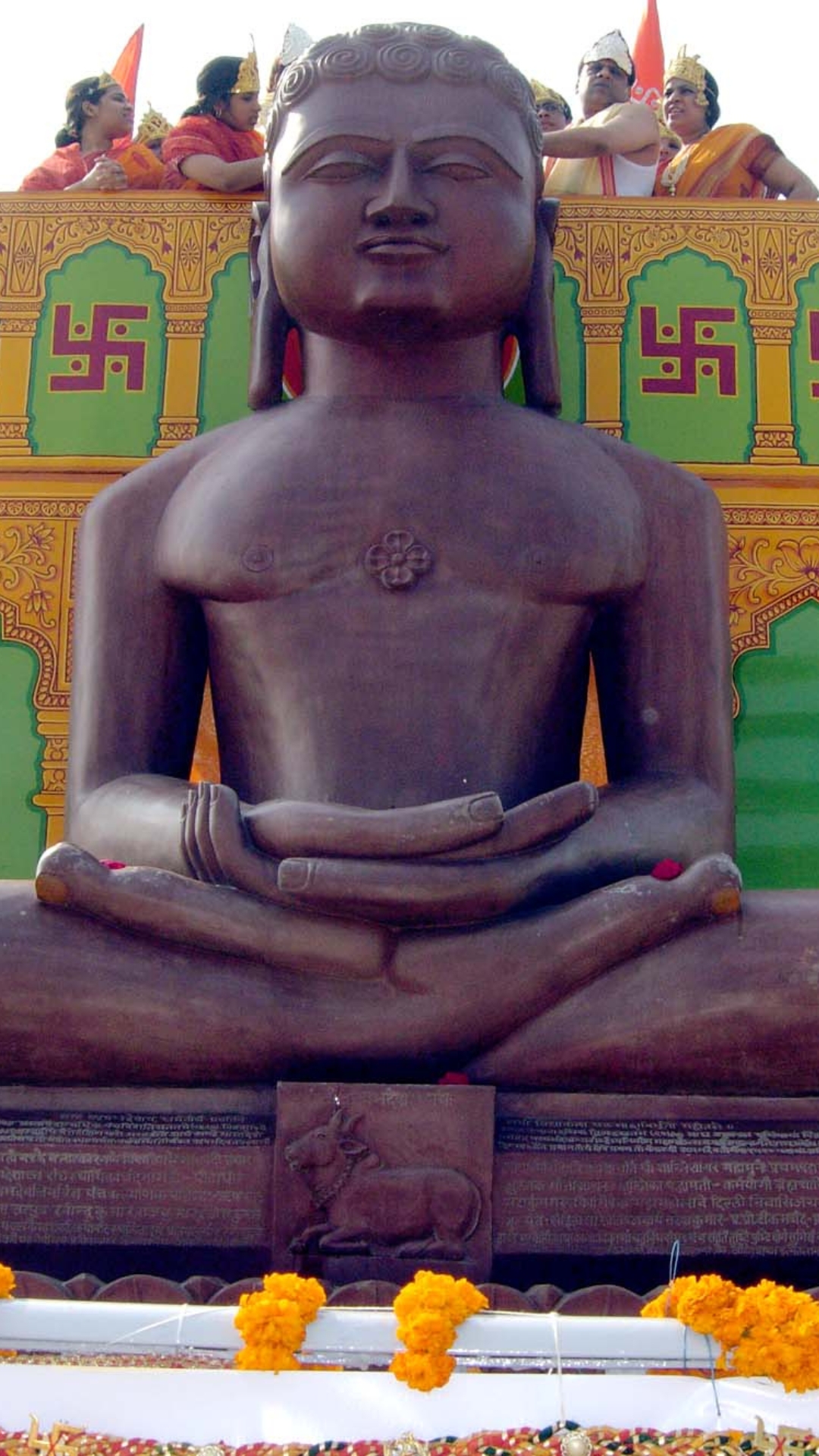
Adinath Bhagwan
This 21-foot idol of Adinath Bhagwan, sculpted in red sandstone, is installed in Durg, Chhattisgarh. It captures the regal simplicity and inner strength of the first Tirthankara, Rishabhnath.
The vibrant red stone used here evokes passion and groundedness—echoing the spiritual foundation of Jain dharma in central India.
Symbolism: Simplicity and origin of Jain path.

HEIGHT
21 Feet

LOCATION
Durg, Chhattisgarh

ESTABLISHED
2018

MATERIAL
Red Sandstone
Ajitnath Bhagwan
This towering idol of Ajitnath Bhagwan, the second Tirthankara, stands at 31 feet in Shanti Sagar Dham, Sammed Shikharji, carved from granite red stone. Located at the most sacred Jain pilgrimage site, this sculpture resonates with the profound energy of salvation and spiritual effort.
Every year, thousands of devotees visit Shikharji to perform yatras, and this idol serves as a centerpiece of reverence.
Spiritual Context: Site of moksha for 20 Tirthankaras.

HEIGHT
31 Feet

LOCATION
Shanti Sagar Dham, Shikharji

ESTABLISHED
2015

MATERIAL
Granite Red Stone
Sheetalnath Bhagwan
A beautiful and compact sculpture of Sheetalnath Bhagwan, this 9-foot idol, made from chocolate Bijolia sandstone, is installed at Bhagalpur Itkauri, Jharkhand. The sculpture is known for its polished surface and soft color, offering a serene and inviting presence.
Despite its modest height, it radiates calm and composure, making it perfect for deep, personal devotion.

HEIGHT
9 Feet

LOCATION
Itkauri, Jharkhand

ESTABLISHED
2019

MATERIAL
Chocolate Bijolia Sandstone
Shantinath, Kunthunath, Arhnath Bhagwan
These three 31-foot idols, sculpted from granite, are housed at Jambudweep in Hastinapur. Representing the 16th, 17th, and 18th Tirthankaras, they are part of a major Jain complex dedicated to universal Jain cosmology.
The statues are surrounded by detailed models of the Jain universe, making this a center for spiritual education and pilgrimage.
Grouping: 3 Tirthankaras in a unified complex.

HEIGHT
31 Feet (Each)

LOCATION
Jambudweep, Hastinapur

ESTABLISHED
2010

MATERIAL
Granite
Parasnath Bhagwan
Parshvanath Bhagwan, the 23rd Tirthankara, was born in Varanasi and renounced royal life to seek spiritual liberation.
He taught the fourfold path of Ahimsa, Satya, Asteya, and Aparigraha, guiding souls toward purity and peace. Protected by the serpent deity Dharanendra, he attained moksha at Sammed Shikharji, a revered Jain pilgrimage site.

HEIGHT
7 Feet

LOCATION
Indirapuram

ESTABLISHED
2019

MATERIAL
Black Granite
Mahaveer Swami
Mahavir Swami Bhagwan, the 24th and last Tirthankara, was born in Kundalpur to King Siddhartha and Queen Trishala.
He renounced royal life at age 30, practiced deep austerity, and preached the path of Ahimsa, Satya, Asteya, Brahmacharya, and Aparigraha. After attaining Keval Gyan, he spread Jain Dharma and achieved moksha at Pavapuri, leaving behind a timeless legacy of non-violence and truth.

HEIGHT
7 Feet

LOCATION
Kunalpur

ESTABLISHED
2019

MATERIAL
Makrana White
Mahaveer Bhagwan
Mahavir Swami Bhagwan, the 24th and last Tirthankara, was born in Kundalpur to King Siddhartha and Queen Trishala.
He renounced royal life at age 30, practiced deep austerity, and preached the path of Ahimsa, Satya, Asteya, Brahmacharya, and Aparigraha. After attaining Keval Gyan, he spread Jain Dharma and achieved moksha at Pavapuri, leaving behind a timeless legacy of non-violence and truth.

HEIGHT
9 Feet

LOCATION
Hastinapur

ESTABLISHED
2021

MATERIAL
Makrana White
Navgrah Shanti Jain Mandir
Navgrah Shanti Jain Mandir in Hastinapur is a unique temple where the nine planetary deities (Navgrahas) are worshipped through a Jain lens of karma and cosmic harmony.
Each graha is represented respectfully, symbolizing the influence of celestial energies on one’s spiritual journey. Devotees perform rituals here to seek inner peace, karmic balance, and protection from planetary obstacles while staying rooted in Jain philosophy.

HEIGHT
5 Inch

LOCATION
Hastinapur

ESTABLISHED
2018

MATERIAL
Sandstone White, Black
Rishabh Dev
This 7-foot idol of Rishabh dev Bhagwan, sculpted in makrana white , is installed in Prayagraj . It captures the regal simplicity and inner strength of the first Tirthankara, Rishabhnath.
The stone used here evokes passion and groundedness—echoing the spiritual foundation of Jain dharma in central India.

HEIGHT
7 Feet

LOCATION
Prayagraj

ESTABLISHED
20XX

MATERIAL
Makrana White
Mahaveer Swami, Mallinath, Neminath
The temples of Lord Mahavir Swami, Mallinath, and Neminath in Gannaur beautifully honor these revered Tirthankaras with unique idols symbolizing their spiritual qualities.
Lord Mahavir’s temple inspires followers with his teachings of non-violence and truth, while Mallinath’s temple reflects purity and liberation. Neminath’s temple, marked by the conch symbol, invites devotees to embrace compassion and renunciation on the path to moksha.

HEIGHT
7 Feet

LOCATION
Gannaur

ESTABLISHED
2018

MATERIAL
Yellow, White, Red
Parshvanath Bhagwan
Parshvanath Bhagwan, the 23rd Tirthankara, was born in Varanasi and renounced royal life to seek spiritual liberation.
He taught the fourfold path of Ahimsa, Satya, Asteya, and Aparigraha, guiding souls toward purity and peace. Protected by the serpent deity Dharanendra, he attained moksha at Sammed Shikharji, a revered Jain pilgrimage site.

HEIGHT
7 Feet

LOCATION
Hastinapur

ESTABLISHED
2015

MATERIAL
Black Stone
Rishabh Dev Bhagwan
This 7-foot idol of Rishabh dev Bhagwan, sculpted in makrana white , is installed in Prayagraj . It captures the regal simplicity and inner strength of the first Tirthankara, Rishabhnath.
The stone used here evokes passion and groundedness—echoing the spiritual foundation of Jain dharma in central India.

HEIGHT
7 Feet

LOCATION
Kailash Parvat

ESTABLISHED
2019

MATERIAL
Red Granite
Munisurathnath Bhagwaan
Muni Suvratnath Bhagwan emphasized unwavering truthfulness, strict self-discipline, and compassion toward all beings.
He taught that conquering desires and practicing non-violence lead to spiritual purity and ultimate liberation. His life inspires followers to live with integrity, humility, and dedication on the path of righteousness.

HEIGHT
5 Feet

LOCATION
Manipuri

ESTABLISHED
2022

MATERIAL
Bhainslana Black
Parshvanath Bhagwan
Parshvanath Bhagwan, the 23rd Tirthankara, was born in Varanasi and renounced royal life to seek spiritual liberation.
He taught the fourfold path of Ahimsa, Satya, Asteya, and Aparigraha, guiding souls toward purity and peace. Protected by the serpent deity Dharanendra, he attained moksha at Sammed Shikharji, a revered Jain pilgrimage site.

HEIGHT
15 Feet

LOCATION
Nazafgarh

ESTABLISHED
2000

MATERIAL
Udaipur Green
Bahubali Bhagwaan
Bahubali Bhagwaan, son of Lord Rishabhanath, is revered for his immense strength and deep meditation.
He stood motionless in penance for a year, symbolizing the triumph of self-control over ego and desires. His story inspires devotion, patience, and the path to spiritual liberation.

HEIGHT
31 Feet

LOCATION
Rishwanchal

ESTABLISHED
2023

MATERIAL
South Granite
Enquire Now
Tell us what you’re looking for—we’ll help you design and create the perfect piece.


